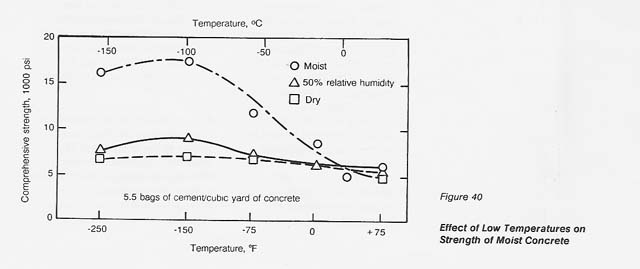Advantages
A concrete space station has the following advantages.
- Large mass: An orbiting station is charged with kinetic energy, of which the velocity is a
relative factor and the mass an absolute factor. In the event of a collision, a larger mass that
possesses greater momentum will always have the dynamic advantage over a smaller one. Reinforced
concrete structures have this advantage over less massive structures.
- Compartmentalization: One of the strong features of concrete is that it can be cast at room
temperature into any monolithic configuration. A concrete space structure should be compartmentalized
to prevent total destruction in case the station is hit by something or a fire occurs.
- Concrete strength: In near- Earth space, temperature may vary from -200°F (-130°C) in the dark to
+ 200° F (+ 93 ° C) facing the Sun (Heppenheimer 1977). The effect of temperature on material strength
is an important consideration in structural design. Some materials soften when heated, and others become
brittle when cooled. Figure 39 shows that the strength of concrete heated to 200°F (93 ° C) is
practically unaffected (Abrams 1973). And the strength of concrete increases as the temperature
goes below the freezing point. Figure 40 shows the strength- temperature relationship for normal
weight maintained at 75-percent relative humidity. Surprisingly, the strength at 150°F (100°C) is
2-1/2 times the strength at room temperature and at 250"F (160°C) is 2 times that at room temperature
(Monfore and Lentz 1962). [The strength of concrete in an oven-dry condition remains constant in the
temperature range from .,250 ° F (-160 ° C) to +250°F (+120°C).}
- Heat resistance: Whereas aluminum softens at 600°F (320°C), concrete is thermally stable up to
1100°F (600°C) (Harmathy 1979). Its low thermal conductivity and high specific heat make it an
excellent heat-resistant construction material.
- Radiation shielding: Most radiation energy will be converted into heat energy
in the course of attenuation in an exposed body. A simple fact explains why
concrete is good for radiation shielding. In general, a hardened concrete
consists of 95 percent aggregate and cement and 5 percent water by weight.
In the energy released from a fission explosion 97 percent is from gamma rays
and 3 percent from fast-flying neutrons. Both aggregate and cement-nonmetallic
and inorganic-are excellent materials for absorbing gamma-ray energy, whereas
water is the best substance for absorbing neutron energy. Although the percentages
for concrete composition are not exactly equal to those for fission energy,
they are close to proportional. Because of its radiation-shielding property,
concrete is used in the construction of nuclear power plants. Thus concrete
would provide a large margin of safety against the hazard of naturally occurring
radiation on the Moon.
- . Abrasion resistance: In addition to asteroids and meteorites, there are micrometeorites and cosmic
dust traveling in space with a relative speed of 25 miles/sec (40 km/sec) (Heide 1964). These microparticles
may abrade the surface of the space station because of the enormous differential velocities. Concrete possesses
high abrasion resistance, resistance which increases proportionally with concrete strength. The relative
depth of a crater made by a microparticle is less in a thick concrete wall than in a thinner wall made of
another material.
- Effect of vacuum: In a vacuum, the free moisture in concrete may eventually evaporate, but not the
chemically bonded water. Figure 39 shows that the loss of free moisture, which generally takes place
around 212°F (100°C), has no adverse effect on concrete strength.
A shortcoming that a pressurized concrete structure may have relates to the airtightness
of concrete. To overcome this difficulty, an epoxy coating or other sealant can be applied on the internal
surface of the concrete structure.


Next
Table of Contents


